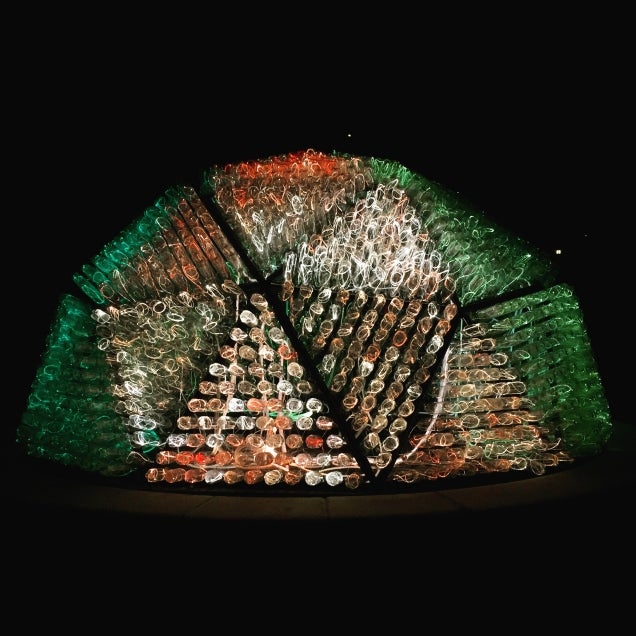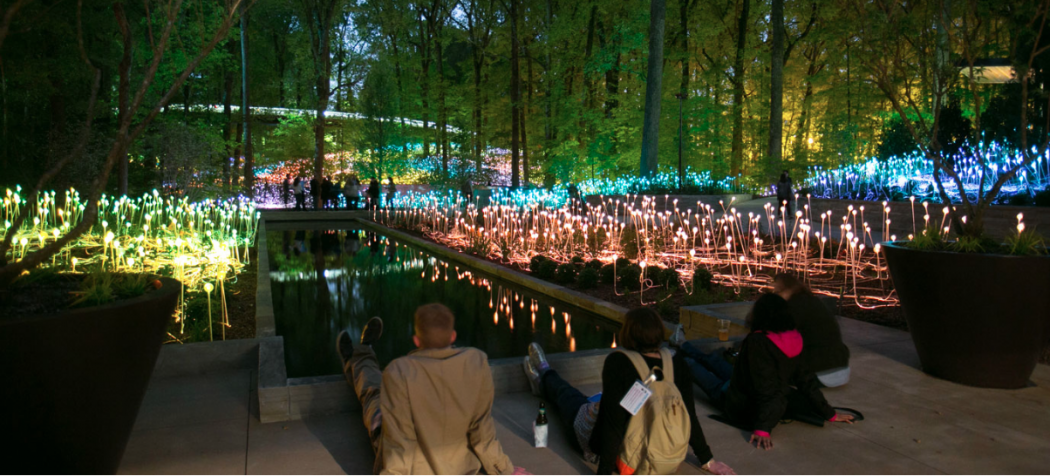
The outdoor exhibition “Bruce Munro: Light in the Garden” at the Atlanta Botanical Garden encourages visitors to see the garden in a new way—after dark. Munro, who is British, created original light-based sculptures and repurposed old favorites to create a multisensory, charming show at the gardens. If you are a fan of flora or a modern-art connoisseur, you will find a lot to love here.
Munro’s work consists mostly of color-changing fiber optic wires sculpted into futuristic but often natural forms. Sometimes he threads fibers optics into bottles, using water inside that acts as a lens distorting and amplifying the color. Another installation uses sproutlike tubes filled with fiber optics that lead to a glowing, color orb on the end—evocative of flowers popping up in a garden. Since this work is best viewed after dark, don’t go in expecting to enjoy both blooms and Munro’s work at the same time. To make the most of the pricey admission ticket, I would suggest going in late afternoon, strolling through the gardens at sunset, having dinner at the café (which is really delicious), and then heading back into the gardens after twilight. This way you can see the transformation of Atlanta Botanical Gardens from landscape to light canvas all in one go.
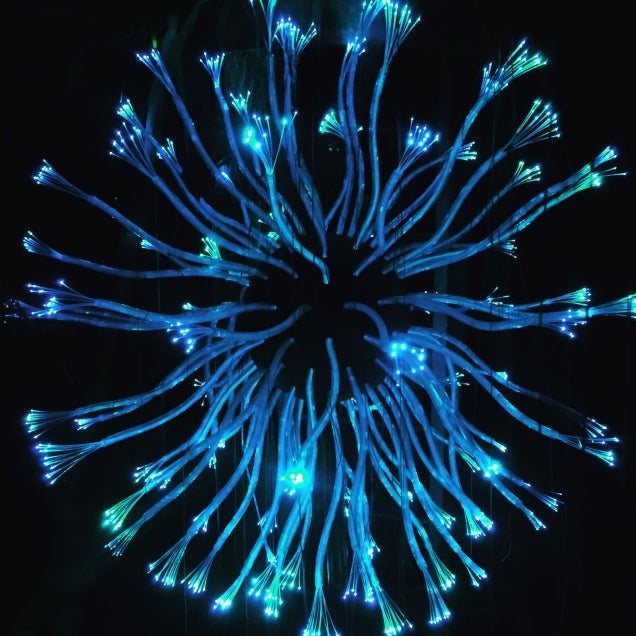
Part of the joy of this show was using other senses besides sight to explore the gardens. I found myself smelling my way through the paths, feeling leaves like velvet brush against me, and listening to the fauna that comes alive at night. Nowhere else was this more enjoyable than in the Fuqua Conservatory with the piece Eden Blooms. These pieces look like unicellular creatures floating among the canopy of tropical plants in the conservatory. Squiggly fiber optics shift color, revealing the different plants and creatures in the space. Being in this darkened greenhouse with the glowing Munro pieces made me appreciate the sounds and smells of this incredible garden.
The iconic Forest of Light is the clear standout of the show; it’s an ever-popular piece Munro has been continually adapting since 2004. Installed in Storza Woods, 30,000 glass bulbs top tender stems, evoking a field of nocturnal flowers that wait for visitors every evening to bloom into color. The stroll across the sky bridge, through the woods, and past Earth Goddess (a permanent acquisition from “Imaginary Worlds”) is the most enchanting part of the Munro show. Almost more interesting than the sculptures themselves are the wires winding their way through the grass to control boxes. These fiber optics running under the sculptures look like nerve cells connecting to the black box brains. These central nervous systems (and there are many throughout the gardens) slowly shift the color of the cables, creating the effect of the sculpture being a living, breathing organism.
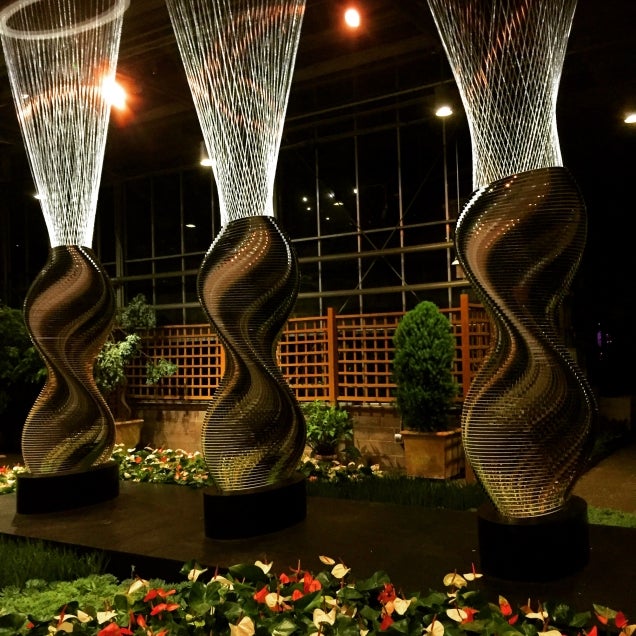
As much I enjoyed this show, it was apparent that sound is not Munro’s medium. Two pieces use sound and I think suffer because of it. The piece Three Degrees—one of two created specifically for this show—uses three reflective, twisting sculptures with fiber optic cables shooting straight up from their tops. Not only does this piece fail to use light creatively, it places a blaring soundtrack in the Fuqua Orchid Center. The usually calming space sounds like a low-rent shopping mall in England playing top-40 hits nobody wants to hear. The meditative piece Water Towers features sound that made no sense to me—some of the sculptures play soulful chanting, and another has, I think, a child screaming. The sound detracts from the peacefulness the piece deserves.
I highly recommend watching the documentary Light: Bruce Munro at Cheekwood before going to the Botanical Gardens. This very enjoyable short doc shows the process and intention behind Munro’s work, and it made my visit more meaningful. Looking at the documentary, it seems the Atlanta installation isn’t as ambitious as some of his previous work, but you still understand the epic amount of toil that goes into these pieces.
The commission of “Bruce Munro: Light” shows that the Atlanta Botanical Gardens is more than just a nature conservatory; this is a world-class arts institution. Although the artists it shows may not be caught up in the philosophical ideals (aka Artspeak nonsense) that underpin much of the artwork at conventional museums, the Garden has brought in contemporary creative professionals to make its space more interesting and relevant to today’s audiences. There’s only a few weeks left to see this show, and I believe it is absolutely worth a visit.
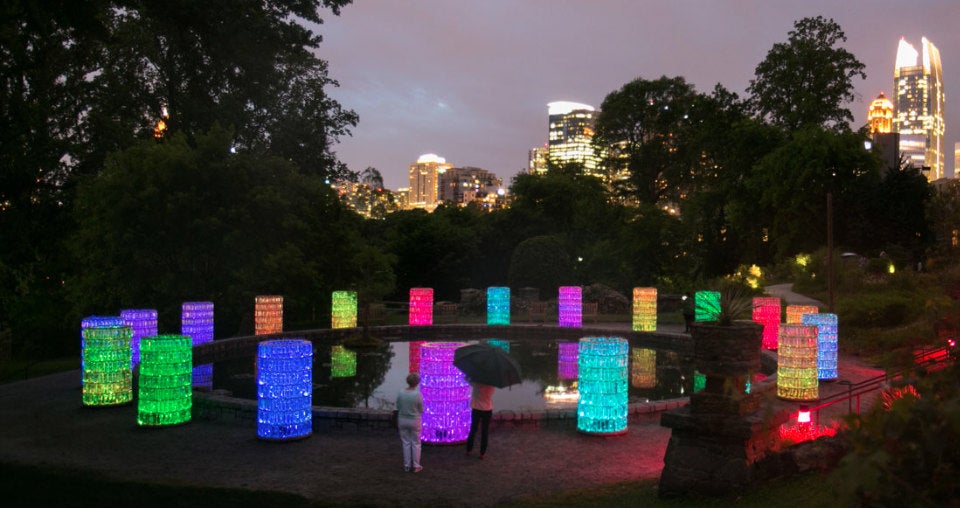
“Bruce Munro: Light” is on view at the Atlanta Botanical Garden through October 3. Special hours for the exhibition are Wednesday-Sunday, 6-11pm. The Garden is open on Labor Day from 9am to 7pm.
Matthew Terrell writes, photographs, and creates videos in the fine city of Atlanta. His work can be found regularly on the Huffington Post, where he covers such subjects as the queer history of the South, drag culture, and gay men’s health issues.
